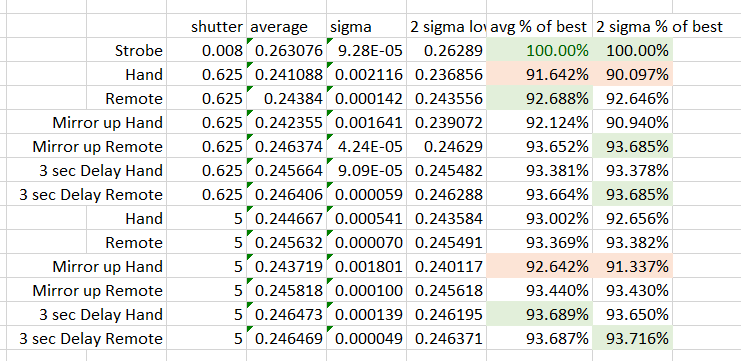I set out to find out what difference some of the shutter release mechanisms made to the image sharpness, using the same setup as I used for the aperture series in the previous post. I mounted the D800E to the StackShot rail that I will be using to make the exposures, and I mounted that to the RRS TVC-34L Versa Series 3 tripod and a RRS BH-55 ball head. I used the Zeiss 100mm f/2 ZF lens, set the ISO to 100, the aperture to f/8.
For a control, I made a series of 10 exposures with the target lit by a strobe. The shutter speed was 1/125, but the effective shutter speed was about 1/8000, since the strobe was set to 1/16 power. I pulled the synch cord from the strobe end, left the modeling light on high, and made a series of exposures at 1/1.6 second: hand tripped, electrically tripped with a wired remote, hand tripped with mirror up, electrically tripped with mirror up, hand tripped with three second shutter delay, and electrically tripped with three seconds shutter delay. Then I turned down the modeling light, set the shutter to five seconds, and did the same series.
Here are the results:
First, the bad news: none of the non-strobe images are anywhere near as sharp as the strobe images. In fact, they are degraded so that they’re close to the sharpness that you’d get with the strobe and the lens either wide open of stopped down all the way.
I’ve marked the worst results in red. Predictably, the hand released images are the worst at 1/1.6 seconds. They’re close to the worst at 5 seconds, too, but the mirror-up hand released images are even worse at that shutter speed. I put this down to chance; note that the standard deviation (sigma) of the hand tripped images is quite high.
If we want dependable results, we should look at the last column, which is the average minus two sigma results. Remote operation is the best, and either flipping the mirror up or using the three-second shutter delay is effective.
But all of the results are disappointingly fuzzy. Why? I suppose that some of it could have to do with the color temperature of the illumination. The strobe is balanced for D50, and the modeling light is much redder than that, especially when turned down for the five-second exposure. Loger wavelengths of light suffer from more diffraction than short ones, so the change in color temperature will make the images using the modeling light alone slightly less sharp. That’s not enough to explain the differences, though.
Next, a more direct attack on camera vibration.

Leave a Reply